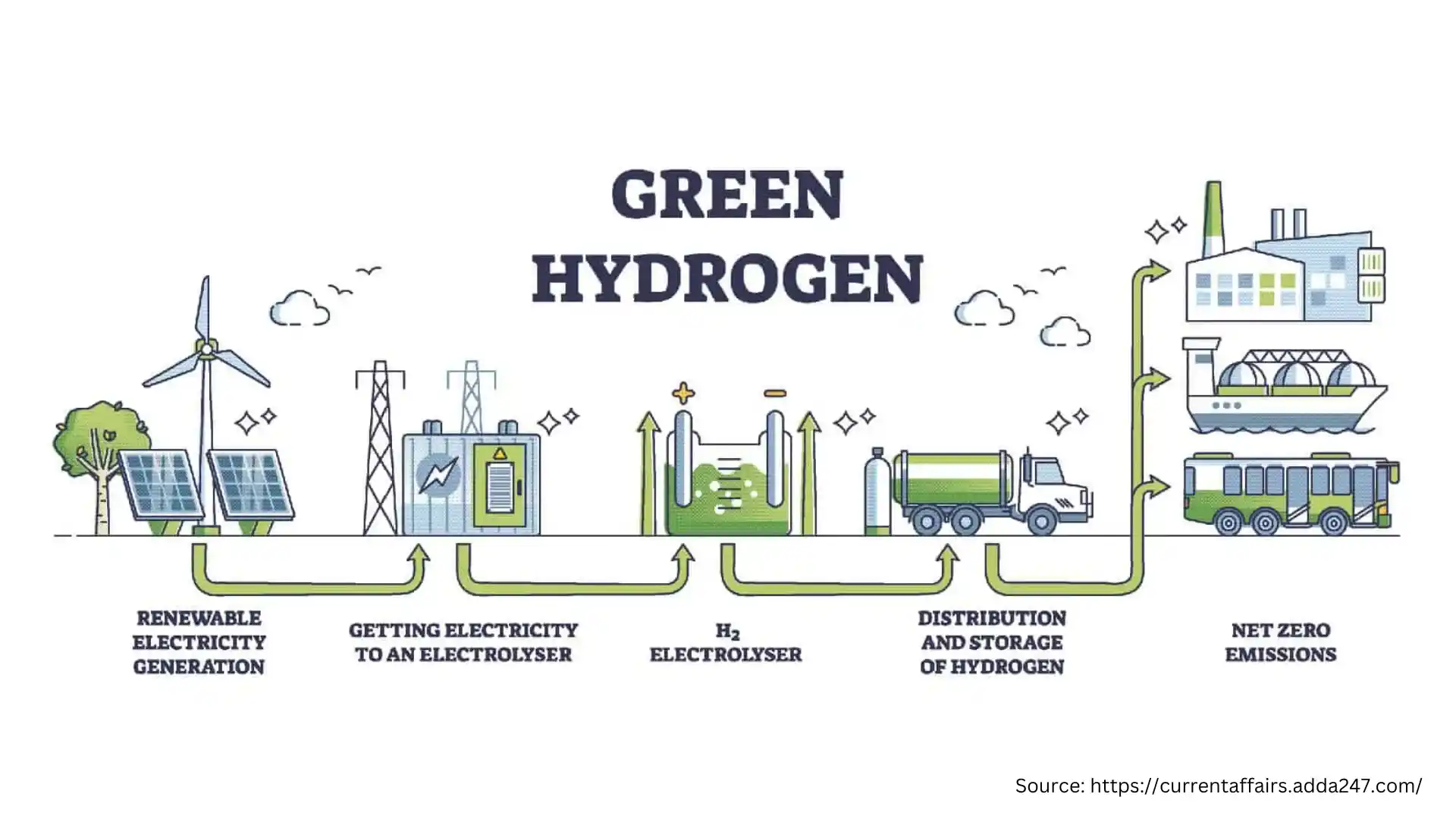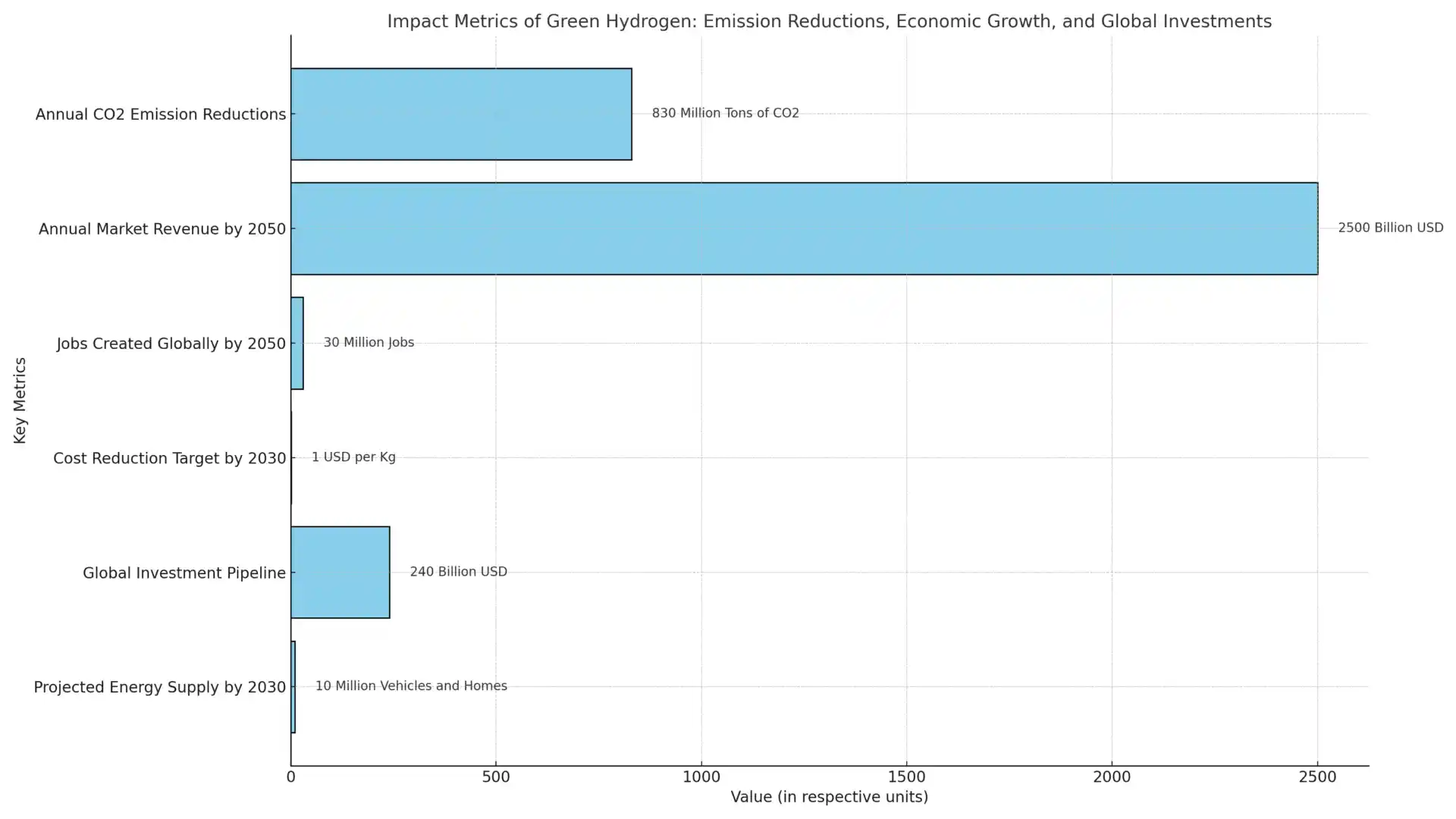Table of Contents
Time is running out for our world to take serious steps against climate change and discover cleaner, more sustainable energies to deal with it. Green hydrogen is rising as a strong candidate between the two sides of this battle. Called “the fuel of the future,” green hydrogen can easily revolutionize industries and energy systems and help reach net-zero carbon emissions.
According to the International Renewable Energy Agency (IRENA), this technology will reduce global CO2 emissions by up to 20% by 2050. This technology could sustainably generate 25% of the world’s energy, turning into a $12 trillion market by mid-century. Countries like Japan, Germany, and Australia have already set aside billions to expedite its deployment.
What is Green hydrogen? How did it earn that attention? This article looks at its transformative potential, its actual applications, and what’s in the way of realizing a hydrogen-fuelled sustainable future.
What Is Green Hydrogen?
At its core, the most abundant element in the universe is undoubtedly hydrogen. However, it is not always eco-friendly to utilize it as an energy carrier. Conventional methods such as steam methane reforming lead to massive carbon emissions attributable to grey hydrogen. This is where green hydrogen comes into play as a cleaner alternative.
Green hydrogen is produced via electrolysis, a method in which electricity is used to separate water into hydrogen and oxygen. Since this electricity comes exclusively from renewable sources, such as wind, solar, or hydropower, the resulting hydrogen could be free of emissions. It is thus an essential part of the puzzle to transition away from fossil fuels.
According to the International Energy Agency (IEA), global production of green hydrogen is set to increase by 500% by 2030, assisted by supportive investments and government policies.
Why Is Green Hydrogen Gaining Momentum?
Several factors have brought green hydrogen to the fore in the energy world:
- Climate Commitments: As more than 70 countries commit to net-zero emissions by mid-century, this technology ranks as one of the key enablers for decarbonizing hard-to-abate industries including steel production, heavy transport, and chemicals.
- Technological Advances: The cost of electrolyzers (the technology by which green hydrogen is produced) has decreased by more than 60% in the past ten years, BloombergNEF reports. Combined with the decreasing prices of renewable energy, this makes the technology economically attractive.
- Government Incentives: In 2022 alone, governments across the world pledged more than $5 billion towards green hydrogen projects, including significant announcements in the European Union, Australia, and Japan. For example, the EU’s “Hydrogen Strategy” seeks to bring, by 2030, the number of electrolyzers operating in the EU to at least 40 GW.
- Energy Security: With the Russia-Ukraine war, energy independence has been highlighted. In much the same way as Germany is doing, other countries are also turning to green hydrogen to decrease their dependence on fossil fuel imports

Real-World Applications of Green Hydrogen
As a technology of wide application, the following is mentioned, amongst which testing and implementation are already underway:
- Transportation: Although electric vehicles are the main subjects in the media, in some fields hydrogen-powered vehicles are gaining ground where batteries are insufficient. Fuel cells are most promising for heavy vehicles, such as trucks, buses, and even trains. Especially, Toyota’s Mirai and Hyundai’s Nexo are taking the first steps toward hydrogen cars.
- Industrial Use: The traditional fuels, coal and natural gas, are being used in sectors such as steel production and ammonia production, for experimenting with clean hydrogen. The Swedish company SSAB recently supplied the world’s first fossil-free steel to use this method.
- Energy Storage: In contrast to batteries, hydrogen can deliver high energy densities for long periods. This is, therefore, a very good solution to mitigate the intermittency of renewable energy sources.
- Power Generation: Hydrogen-driven turbines are in development as a substitute for natural gas in power plant applications. Japan’s Fukushima Hydrogen Energy Research Field (FH2R) is a model for how this technology can be woven into the power grid.
The Numbers Behind the Revolution
The potential emission reduction effect of this clean energy supply to the world is unprecedented. Let’s delve into the data driving this revolution:
- Emission Reductions: According to the IEA, replacing grey hydrogen with its cleaner counterpart could cut annual CO2 emissions by 830 million tons. This is the equivalent of the annual emissions of the United Kingdom and France together.
- Economic Potential: According to McKinsey, the market could reach a market capitalization of $2.5 trillion annually by 2050 and provide over 30 million jobs worldwide. These careers cover a range of industries ranging from manufacturing and technology through supply chains to logistics and energy infrastructure.
- Cost Innovations: The Department of Energy’s “Hydrogen Shot” initiative in the U.S. seeks to bring production costs down to $1 per kilogram by 2030—a substantial reduction from the $5-$6 per kilogram currently. Reaching this goal would bring this technology into the same league as mainstream fossil fuels.
- Global Investments: A report by the World Economic Forum points out that there are already project values of $240 billion in the pipeline consisting of. Leading actors, such as Europe, Australia, and the Middle East, are fronting these initiatives to increase production and infrastructure.
- Energy Supply: With the 2030 target, the number of vehicles fuelled by hydrogen is expected to reach at least 10 million and it is expected that 500,000 electric homes will be powered by the green source in the year 2030 in Europe.

Breaking Barriers: Challenges and Creative Solutions
Even though there is huge promise in green hydrogen, some hurdles are still necessary to overcome. For every challenge, however, innovative solutions are emerging:
The Cost Conundrum
- Challenge: Although the cost of green hydrogen has fallen, it is still more expensive than grey or blue hydrogen (which is produced with carbon capture). This price gap hinders its widespread adoption.
- Solution: Scaling up production and realizing economies of scale can make costs cheaper. Actions such as the U.S. Department of Energy’s “Hydrogen Shot”, to reduce production costs to $1 per kilogram by 2030, are critical. Innovations in electrolyzer performance and renewable energy integration are also important.
Infrastructure Gaps
- Challenge: The lack of an efficient hydrogen distribution network creates logistic difficulties. Pipelines, storage tanks, and charging stations are few and expensive to construct.
- Solution: Public-private partnerships are being developed to finance and build hydrogen infrastructure. Firms, such as Air Liquide and Linde, are at the forefront of providing modular hydrogen refueling stations to speed up their deployment.
Energy Demand Dilemma
- Challenge: Producing hydrogen requires large amounts of renewable electricity. Reconciling this demand with other energy demands is a tricky proposition.
- Solution: Technological developments in the power capacity of renewables (i.e., floating offshore wind farms) and solar-to-hydrogen technologies are being utilized to fulfill the clean energy hydrogen production dual demand. Grid optimization and energy storage innovations further enhance efficiency.
Storage and Transportation Complexities
- Challenge: The low energy density of hydrogen thus poses the challenge of its storage and transportation which necessitates the use of high-pressure tanks/cryogenic systems.
- Solution: Studies in high-performance materials including metal hydrides and liquid organic hydrogen carriers (LOHCs) present potential solutions. These technologies improve safety and efficiency in hydrogen logistics.
A Future Powered by Green Hydrogen
Imagine a world where airliners run on hydrogen, factories produce goods without emitting carbon, and homes are powered by renewable hydrogen fuel cells. This vision isn’t as far-fetched as it once seemed.
Countries such as Australia aspire to become green hydrogen superpowers by capitalizing on massive solar and wind resources available to produce hydrogen to export. Also, India’s National Hydrogen Mission has the objective of making India a global center for production.
At the micro level, standalone consumers could soon be able to access hydrogen-based residential energy systems, thereby democratizing clean energy. With the increase in adoptions, green hydrogen might be as common as solar panels are for being today.
Why You Should Care
Green hydrogen is no longer just a trendy term, it is a real game-changer against climate change. Supporting its development—whether through policy, investment, or consumer demand—could accelerate the transition to a cleaner, more sustainable future. By embracing this technology, we’re not just reducing emissions; we’re redefining what’s possible in the realm of energy.
As projections show in this industry it is predicted that it could generate 30 million jobs worldwide, and reduce more than 800 million tons of CO2 each year, then the stakes are too high. This transformation has the potential to change industries, and the economy and to shape a green world for future generations.
Will you follow the flowing tide back to a green future?